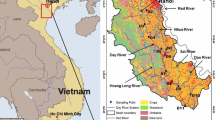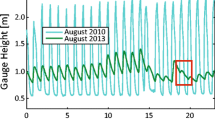Abstract
The feasibility of using nitrogen and oxygenisotope ratios of nitrate (NO3 −) forelucidating sources and transformations ofriverine nitrate was evaluated in a comparativestudy of 16 watersheds in the northeastern U.S.A. Stream water was sampled repeatedly at theoutlets of the watersheds between January andDecember 1999 for determining concentrations,δ15N values, and δ18Ovalues of riverine nitrate.
In conjunction with information about land useand nitrogen fluxes,δ15Nnitrate andδ18Onitrate values providedmainly information about sources of riverinenitrate. In predominantly forested watersheds,riverine nitrate had mean concentrations ofless than 0.4 mg NO3 −-N L−1,δ15Nnitrate values of lessthan +5‰, and δ18Onitratevalues between +12 and +19‰. This indicatesthat riverine nitrate was almost exclusivelyderived from soil nitrification processes withpotentially minor nitrate contributions fromatmospheric deposition in some catchments. Inwatersheds with significant agricultural andurban land use, concentrations of riverinenitrate were as high as 2.6 mg NO3 −-NL−1 with δ15Nnitratevalues between +5 and +8‰ andδ18Onitrate values generallybelow +15‰. Correlations between nitrateconcentrations, δ15Nnitratevalues, and N fluxes suggest that nitrate inwaste water constituted a major, and nitrate inmanure a minor additional source of riverinenitrate. Atmospheric nitrate deposition ornitrate-containing fertilizers were not asignificant source of riverine nitrate inwatersheds with significant agricultural andurban land use. Although complementary studiesindicate that in-stream denitrification wassignificant in all rivers, the isotopiccomposition of riverine nitrate sampled at theoutlet of the 16 watersheds did not provideevidence for denitrification in the form ofelevated δ15Nnitrate andδ18Onitrate values. Relativelylow isotopic enrichment factors for nitrogenand oxygen during in-stream denitrification andcontinuous admixture of nitrate from theabove-described sources are thought to beresponsible for this finding.
Similar content being viewed by others
References
Amberger A & Schmidt HL (1987) Natürliche Isotopengehalte von Nitrat als Indikatoren für dessen Herkunft. Geochim. Cosmochim. Acta. 51: 2699–2705
Aravena R, Evans ML & Cherry JA (1993) Stable isotopes of oxygen and nitrogen in source identification of nitrate from septic systems. Ground Water 31: 180–186
Aravena R & Robertson WD (1998) Use of multiple isotope tracers to evaluate denitrification in ground water: study of nitrate from a large-flux septic system plume. Ground Water 36: 975–982
Blackmer AM & Bremner JM (1977) Nitrogen isotope discrimination in denitrification of nitrate in soils. Soil Biol. Biochem. 9: 73–77
Böttcher J, Strebel O, Voerkelius S & Schmidt H-L (1990) Using isotope fractionation of nitrate-nitrogen and nitrate-oxygen for evaluation of microbial denitrification in a sandy aquifer. J. Hydrol. 114: 413–424
Boyer EW, Goodale CL, Jaworski NA & Howarth RW(2002) Anthropogenic nitrogen sources and relationships to riverine nitrogen export in the northeastern U.S.A. Biochemistry 57/58: 137–169
Bräuer K & Strauch G (2000) An alternative procedure for the 18O measurement of nitrate oxygen. Chem. Geol. 168: 283–290
Cey EE, Rudolph DL, Aravena R & Parkin G (1999) Role of the riparian zone in controlling the distribution and fate of agricultural nitrogen near a small stream in southern Ontario. J. Contaminant Hydrol. 37: 45–67
Chang CCY, Langston J, Riggs M, Campbell DH, Silva SR & Kendall C (1999) A method for nitrate collection for δ15N and δ18O analysis from waters with low nitrate concentrations. Can. J. Fish. Aquat. Sci. 56: 1856–1864
Cooper AB (1990) Nitrate depletion in the riparian zone and stream channel of a small headwater catchment. Hydrobiologia 202: 13–26
Duff JH & Triska FJ (1990) Denitrification in sediments from the hyporheic zone adjacent to a small forested stream. Can. J. Fish. Aquat. Sci. 47: 1140–1147
Durka W, Schulze E-D, Gebauer G & Voerkelius S (1994) Effects of forest decline on uptake and leaching of deposited nitrate determined from 15N and 18O measurements. Nature 372: 765–767
Epstein S & Mayeda T (1953) Variation of O-18 content of waters from natural sources. Geochim. Cosmochim. Acta. 4: 213–224
Farrell RE, Sandercock PJ, Pennock DJ & Van Kessel C (1996) Landscape-scale variations in leached nitrate: relationship to denitrification and natural nitrogen-15 abundance. Soil Sci. Soc. Am. J. 60: 1410–1415
Fogg GE, Rolston DE, Decker DL, Louie DT & Grismer ME (1998) Spatial variation in nitrogen isotope values beneath nitrate contamination sources. Ground Water 36: 418–426
Fustec E, Mariotti A, Grillo X & Sajus J (1991) Nitrate removal by denitrification in alluvial ground water: role of a former channel. J. Hydrol. 123: 337–354
Goolsby DA (2000) Mississippi basin nitrogen flux believed to cause gulf hypoxia. EOS 81: 321–327
Gormly JR & Spalding RF (1979) Sources and concentrations of nitrate-nitrogen in ground water of the Central Platte Region, Nebraska. Ground Water 17: 291–301
Harrington RR, Kennedy BP, Chamberlain CP, Blum JD & Folt CL (1998) 15N enrichment in agricultural catchments: field patterns and applications to tracking Atlantic salmon (Salmo salar). Chem. Geol. 147: 281–294
Heaton THE (1986) Isotopic studies of nitrogen pollution in the hydrosphere and atmosphere: a review. Chem. Geol. 5: 87–102
Hedin LO, Armesto JJ & Johnson AH (1995) Patterns of nutrient loss from unpolluted, oldgrowth temperate forests: evaluation of biogeochemical theory. Ecology 76: 493–509
Hill AR (1996) Nitrate removal in stream riparian zones. J. Environ. Qual. 25: 743–755
Howarth RW, Billen G, Swaney D, Townsend A, Jaworski N, Lajtha K, Downing JA, Elmgren R, Caraco N, Jordan T, Berendse F, Freney J, Kudeyarov V, Murdoch P & Zhao-Liang (1996) Regional nitrogen budgets and riverine N & P fluxes for the drainages to the North Atlantic Ocean: natural and human influences. Biogeochem. 35: 75–139
Hübner H (1986) Isotope effects of nitrogen in the soil and biosphere. In: Fritz P & Fontes JC (Eds) Handbook of Environmental Isotope Geochemistry: The Terrestrial Environment (pp 361–425). Elsevier, Amsterdam
Jaworski NA & Hetling LJ (1996) Water quality trends of Mid-Atlantic and northeast watersheds over the past 100 years. Presented at Watershed's 96, Baltimore, MD
Kellman L & Hillaire-Marcel C (1998) Nitrate cycling in streams: using natural abundances of NO3 - δ15N to measure in-situ denitrification. Biogeochemistry 43: 273–292
Kendall C (1998) Tracing nitrogen sources and cycling in catchments. In: Kendall C & McDonnell JJ (Eds) Isotope Tracers in Catchment Hydrology (pp 521–576). Elsevier, Amsterdam
Kinzing AP & Socolow RH (1994) Human impacts on the nitrogen cycle. Physics Today (November 1994): 24–31
Knowles R (1982) Denitrification. Microbiol. Rev. 46: 43–70
Knowles R & Blackburn TH (1993) Nitrogen Isotope Techniques. Academic Press, San Diego, 311 pp
Kreitler CW (1979) Nitrogen-isotope ratio studies of soils and groundwater nitrate from alluvial fan aquifers in Texas. J. Hydrol. 42: 147–170
Kreitler CW & Browning LA (1983) Nitrogen-isotope analysis of groundwater nitrate in carbonate aquifers: natural sources versus human pollution. J. Hydrol 61: 285–301
Kreitler CW & Jones DC (1975) Natural soil nitrate: the cause of the nitrate contamination of ground water in Runnels County, Texas. Ground Water 13: 53–61
Letolle R (1980) Nitrogen-15 in the natural environment. In: Fritz P & Fontes JC (Eds) Handbook of Environmental Isotope Geochemistry: The Terrestrial Environment (pp 407–433). Elsevier, Amsterdam
Lowrance R, Vellidis G & Hubbard RK (1995) Denitrification in a restored riparian forest wetland. J. Environ. Qual. 24: 808–815
Macko SA & Ostrom NE (1994) Pollution studies using stable isotopes. In: Lajtha K & Michener RH (Eds) Stable Isotopes in Ecology and Environmental Science (pp 45–62). Blackwell Scientific Publications, Oxford
Mariotti A, Germon JC, Hubert P, Kaiser P, Letolle R, Tardieux A & Tardieux P (1981) Experimental determination of nitrogen kinetic isotope fractionation: some principles; illustration for the denitrification and nitrification processes. Plant and Soil 62: 413–430
Mariotti A, Germon JC & Leclerc A (1982) Nitrogen isotope fractionation associated with the NO2 →N2O step of denitrification in soils. Can. J. Soil Sci. 62: 227–241
Mariotti A, Landreau A & Simon B (1988) 15N isotope biogeochemistry and natural denitrification process in ground water: application to the chalk aquifer in northern France. Geochim. Cosmochim. Acta. 52: 1869–1878
Mayer B, Bollwerk SM, Mansfeldt T, Hütter B & Veizer J (2001) The oxygen isotope composition of nitrate generated by nitrification in acid forest floors. Geochim. Cosmochim. Acta. 65: 2743–2756
McClelland JW & Valiela I (1998) Linking nitrogen in estuarine producers to land derived sources. Limnol. Oceanogr. 43: 577–585
McClelland JW, Valiela I & Michener RH (1997) Nitrogen-stable isotope signatures in estuarine food webs: a record of increasing urbanization in coastal watersheds. Limnol. Oceanogr. 42: 930–937
Mengis M, Schiff SL, Harris M, English MC, Aravena R, Elgood RJ & MacLean A (1999) Multiple geochemical and isotopic approaches for assessing ground water NO3 - elimination in a riparian zone. Ground Water 37: 448–457
Nadelhoffer KJ & Fry B (1994) Nitrogen isotope studies in forest ecosystems. In: Lajtha K & Michener RM (Eds) Stable Isotopes in Ecology and Environmental Science (pp 22–44). Blackwell Scientific Publishers, Oxford
Ostrom NE, Knoke KE, Hedin LO, Robertson GP & Smucker AJM (1998) Temporal trends in nitrogen isotope values of nitrate leaching from an agricultural soil. Chem. Geol. 146: 219–227
Paces T (1982) Natural and anthropogenic fluxes of major elements from Central Europe. Ambio. 11: 206–208
Revesz K, Böhlke JK & Yoshinari T (1997) Determination of δ18O and δ15N in nitrate. Anal. Chem. 69: 4375–4380
Richards RP & Holloway J (1987) Monte carlo studies of sampling strategies for estimating tributary loads. Water Resources Research 23: 1939–1948
Sebilo M, Billen G, Grably M & Mariotti A (in review) Isotopic composition of nitratenitrogen as a marker of riparian and benthic denitrification at the scale of the whole Seine River system. Biogeochemistry, forthcoming
Seitzinger PS, Styles RV, Boyer E, Alexander RB, Billen G, Howarth RW, Mayer B & Van Breemen N (2002) Nitrogen retention in rivers: model development and application to watersheds in the northeastern U.S.A. Biogeochemistry 57/58: 199–237
Silva SR, Kendall C, Wilkinson DH, Ziegler AC, Chang CCY & Avanzino RJ (2000) A new method for collection of nitrate from fresh water and the analysis of nitrogen and oxygen isotope ratios. J. Hydrol. 228: 22–36
Sollins P & McCorison FM (1981) Nitrogen and carbon solution chemistry of an old growth coniferous forest watershed before and after cutting.Water Resources Research 17: 1409–1418
Stottlemyer R & Troendle CA (1992) Nutrient concentration patterns in streams draining alpine and subalpine catchments, Fraser Experimental Forest, Colorado. J. Hydrol. 140: 179–208
Turner RE & Rabalais NN (1991) Changes in Mississippi River water quality this century. BioSci. 41: 140–147
USGS (2000) National water information system data retrieval. http://waterdata.usgs.gov/nwis-w/US/. USGS
Van Breemen N, Boyer EW, Goodale CL, Jaworski NA, Seitzinger S, Paustian K, Hetling L, Lajtha K, Eve M, Mayer B, Van Dam D, Howarth RW, Nadelhoffer KJ & Billen G (2002) Where did all the nitrogen go? Fate of nitrogen inputs to large watersheds in the northeastern U.S.A. Biogeochemistry 57/58: 267–293
Vanderbilt KL & Lajtha K (2002) Annual and seasonal patterns of nitrogen dynamics at the H. J. Andrews Experimental Forest, Oregon. Biogeochemistry, in review
Vitousek PM, Aber JD, Howarth RW, Likens GE, Matson PA, Schindler DW, Schlesinger WH & Tilman DG (1997) Human alteration of the global nitrogen cycle: sources and Consequences. Ecol. Appl. 7: 737–750
Voerkelius S (1990) Isotopendiskriminierungen bei der Nitrifikation und Denitrifikation: Grundlagen und Anwendungen der Herkunfts-Zuordnung von Nitrat und Distickstoffmonoxid. PhD thesis TU Munich, Munich, 119 pp
Warwick J & Hill AR (1988) Nitrate depletion in the riparian zone of a small woodland stream. Hydrobiologia 157: 231–240
Wassenaar L I (1995) Evaluation of the origin and fate of nitrate in the Abbotsford Aquifer using the isotopes of 15N and 18O in NO3 -. Appl. Geochem. 10: 391–405
Author information
Authors and Affiliations
Corresponding author
Rights and permissions
About this article
Cite this article
Mayer, B., Boyer, E.W., Goodale, C. et al. Sources of nitrate in rivers draining sixteen watersheds in the northeastern U.S.: Isotopic constraints. Biogeochemistry 57, 171–197 (2002). https://doi.org/10.1023/A:1015744002496
Issue Date:
DOI: https://doi.org/10.1023/A:1015744002496




